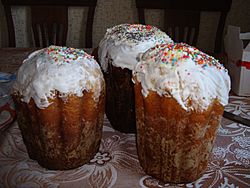Kulich facts for kids
 |
|
| Type | Yeast cake |
|---|---|
| Course | Before breakfast |


Kulich (pronounced koo-LEECH) is a special bread made for Easter in many Eastern European countries. It's often called "Easter bread." This tall, round bread is a very important part of Easter celebrations.
The tradition of making Kulich comes from the Byzantine Empire. It is popular in countries with many Orthodox Christian people. These countries include Russia, Belarus, Ukraine, Romania, Georgia, Moldova, North Macedonia, and Serbia. Kulich is a type of paska Easter bread. It celebrates not only Easter but also the arrival of spring. In these countries, Easter is often even more important than Christmas.
How Kulich is Prepared
After the Easter church service, people traditionally take their Kulich to be blessed by a priest. The bread is placed in a basket and decorated with bright, colorful flowers.
Blessed Kulich is usually eaten before breakfast each day during the Easter season. Any Kulich that wasn't blessed is often enjoyed as a dessert. It is eaten with a special sweet cheese dish called paskha.
Kulich is baked in tall, round containers. These can be like coffee tins or fruit juice tins. Once the bread cools down, it is decorated. It usually has white icing that drips a little down the sides. People also add colorful flowers or sprinkles on top.
Historically, Kulich was often served with a cheese paskha that had the letters ХВ on it. These letters stand for "Христос воскрес" (Khristos voskres), which means "Christ is risen." This is a traditional Easter greeting.
People usually eat Kulich only between Easter and a holiday called Pentecost. The recipe for Kulich is similar to an Italian sweet bread called panettone. However, Kulich is usually much denser and heavier.
Gallery
See also
 In Spanish: Kulich para niños
In Spanish: Kulich para niños





